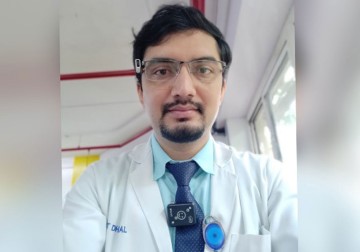A new study by Pavan K. Verkicharla and others from L V Prasad Eye Institute, Hyderabad, India and Centre for Applied Vision Research, School of Health Sciences, University of London, UK validates MyLyt (a low-cost, LVPEI-made light tracker) to track light exposure in children.
Myopia is one of the leading causes of vision impairment in the world. It is a condition where an elongated eye focuses light in front of the retina, leading to blurred vision. Children who spend more time indoors doing near-work are at particular risk of myopia. It is estimated that by 2050, nearly 50% of the world population will be myopic because of modern society’s propensity for near-work. We now know that as long as children have adequate exposure to sunlight, myopia can be prevented. But how much is ‘adequate’? And how do you measure a child’s exposure to sunlight?
For a long time, tracking exposure to light was only possible using subjective tools like diaries and questionnaires. These data collection techniques are error-prone and are being replaced by more precise and light-weight wearable devices. Worn on wrists or strapped to a collar, these new-age trackers can accurately measure light-exposure. In fact, a lot of new research based on these devices is showing that children with myopia are exposed to lower illuminance levels and for shorter periods of time. Unfortunately, these trackers are expensive, which limits their use in clinical and research settings especially in countries like India.
A new study by Pavan K. Verkicharla and others published in the Ophthalmic & Physiological Optics validates the ‘MyLyt’ illuminance tracker developed in-house at LVPEI. The study had two phases: clinical validation of MyLyt against a gold-standard digital lux meter (that measures ambient luminance) and reporting the findings of a real-world feasibility study. In phase one, the device was validated against the lux meter in three different light environments: a custom chamber, natural indoor, and outdoor. In phase two, MyLyt was distributed to a group of volunteers (21 adults and 8 children), who maintained an ‘activity diary’, a real-time log.
The study found that the MyLyt tracker was comparable to the lux meter in all the three tested environments. There were non-significant differences in recorded lux levels between the two, and variance increased as brightness increased, but the absolute differences were small. The authors do not expect these above differences to matter for myopia clinical practice or research. The MyLyt tracker also exhibited high repeatability and was successful in differentiating between the three environments it was tested in. The MyLyt tracker is inexpensive and sturdy. Its chest-mounted clip design means it can be used by children who do not have spectacles also. MyLyt has the potential to nudge its users to spend more time outdoors and stem the myopia tide.
‘MyLyt is inexpensive, accurate, and effective,’ says Pavan Verkicharla, the corresponding author and Head, Myopia Research Lab at LVPEI. ‘It is the kind of device that can be a game-changer in our efforts to prevent Myopia’.
Citation
Dhakal R, Rudrapankte JR, Chittajallu HSN, Lawrenson JG, Huntjens B, Shah R, et al. Development and validation of a ‘MyLyt’ wearable light tracking device. Ophthalmic Physiol Opt. 2022;00:1–9. https://doi.org/10.1111/opo.13061



